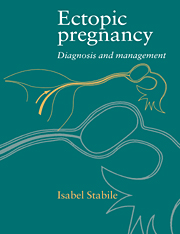Book contents
- Frontmatter
- Contents
- 1 Incidence, aetiology and pathophysiology of ectopic pregnancy
- 2 Clinical presentation of ectopic pregnancy
- 3 Biochemical diagnosis of ectopic pregnancy
- 4 Ultrasound diagnosis of ectopic pregnancy
- 5 Surgical diagnosis
- 6 Practical management of suspected ectopic pregnancy
- 7 Extratubal and unusual ectopic pregnancies
- 8 Medical treatment of ectopic pregnancy
- 9 Conservative and expectant management of ectopic pregnancy
- 10 Radical surgery
- 11 Pregnancy after ectopic pregnancy
- Epilogue: the future
- Index
1 - Incidence, aetiology and pathophysiology of ectopic pregnancy
Published online by Cambridge University Press: 26 March 2010
- Frontmatter
- Contents
- 1 Incidence, aetiology and pathophysiology of ectopic pregnancy
- 2 Clinical presentation of ectopic pregnancy
- 3 Biochemical diagnosis of ectopic pregnancy
- 4 Ultrasound diagnosis of ectopic pregnancy
- 5 Surgical diagnosis
- 6 Practical management of suspected ectopic pregnancy
- 7 Extratubal and unusual ectopic pregnancies
- 8 Medical treatment of ectopic pregnancy
- 9 Conservative and expectant management of ectopic pregnancy
- 10 Radical surgery
- 11 Pregnancy after ectopic pregnancy
- Epilogue: the future
- Index
Summary
Definition
Tubal, ectopic and extrauterine are terms used to describe pregnancies occurring outside the uterine cavity. While tubal pregnancies are located strictly within the fallopian tube, the latter two terms include ovarian and abdominal pregnancies, as well as those implanting in the oviduct. An ovum may be fertilised and remain at any point along its passage from the ovary to the uterus (Figure 1.1).
Incidence: is it increasing?
The incidence of ectopic pregnancy ranges between 0.25% and 1.4% of all pregnancies, i.e. the sum of reported live births, legal induced abortions and ectopic pregnancies (Chow et al.y 1987; Coste et al.y 1994). Controversy has arisen over the ideal denominator in reporting the incidence of ectopic pregnancy (Box 1.1). Barnes and colleagues (1983) have shown that the estimated rate of ectopic pregnancy in New England can vary up to 35-fold depending on the denominator used. Another limitation in accurately identifying ectopic pregnancy rates is the problem of ensuring that the diagnosis is not missed, especially in very early cases which may spontaneously resolve. Comparative rates of ectopic pregnancy in France, Finland and the USA are listed in Table 1.1. In 1992, ectopic pregnancies accounted for approximately 2% of reported pregnancies in the USA and ectopic pregnancy-related deaths accounted for 9% of all pregnancy-related deaths (NCHS, 1994). The estimated total number of ectopic pregnancies obtained from inpatient and outpatient data was 47% higher than that obtained from hospitalisations only (MMWR, 1995).
- Type
- Chapter
- Information
- Ectopic PregnancyDiagnosis and Management, pp. 1 - 13Publisher: Cambridge University PressPrint publication year: 1996



